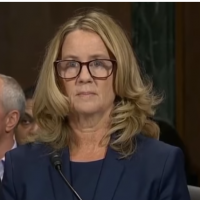 #9 – The activities of congressional Democrats and Dr. Ford’s attorneys likely affected Dr. Ford’s account
#9 – The activities of congressional Democrats and Dr. Ford’s attorneys likely affected Dr. Ford’s account
(Ryan Saavedra – Daily Wire) Rachel Mitchell, the prosecutor who questioned Christine Blasey Ford last week during a hearing in front of the Senate Judiciary Committee, wrote a five-page memo that was released on Sunday that outlines why she would not bring criminal charges against Supreme Court nominee Brett Kavanaugh.
Mitchell’s memo notes nine significant problems with Ford’s testimony and underscores that her case is “even weaker” than a “he said, she said” case.
“A ‘he said, she said’ case is incredibly difficult to prove,” Mitchell states. “But this case is even weaker than that. Dr. Ford identified other witnesses to the event, and those witnesses either refuted her allegations or failed to corroborate them. For the reasons discussed below, I do not think that a reasonable prosecutor would bring this case based on the evidence before the Committee. Nor do I believe that this evidence is sufficient to satisfy the preponderance-of-the-evidence standard.”
Here are the nine problems outlined in Mitchell’s memo:
1. Dr. Ford has not offered a consistent account of when the alleged assault happened:
- In a July 6 text to the Washington Post, she said it happened in the “mid 1980s.”
- In her July 30 letter to Senator Feinstein, she said it happened in the “early 80s.”
- Her August 7 statement to the polygrapher said that it happened one “high school summer in early 80’s,” but she crossed out the word “early” for reasons she did not explain.
- A September 16 Washington Post article reported that Dr. Ford said it happened in the “summer of 1982.”
- Similarly, the September 16 article reported that notes from an individual therapy session in 2013 show her describing the assault as occurring in her “late teens.” But she told the Post and the Committee that she was 15 when the assault allegedly occurred. She has not turned over her therapy records for the Committee to review.
- While it is common for victims to be uncertain about dates, Dr. Ford failed to explain how she was suddenly able to narrow the timeframe to a particular season and particular year
2. Dr. Ford has struggled to identify Judge Kavanaugh as the assailant by name:
- No name was given in her 2012 marriage therapy notes.
- No name was given in her 2013 individual therapy notes.
- Dr. Ford’s husband claims to recall that she identified Judge Kavanaugh by name in 2012. At that point, Judge Kavanaugh’s name was widely reported in the press as a potential Supreme Court nominee if Governor Romney won the presidential election.
- In any event, it took Dr. Ford over thirty years to name her assailant. Delayed disclosure of abuse is common so this is not dispositive.